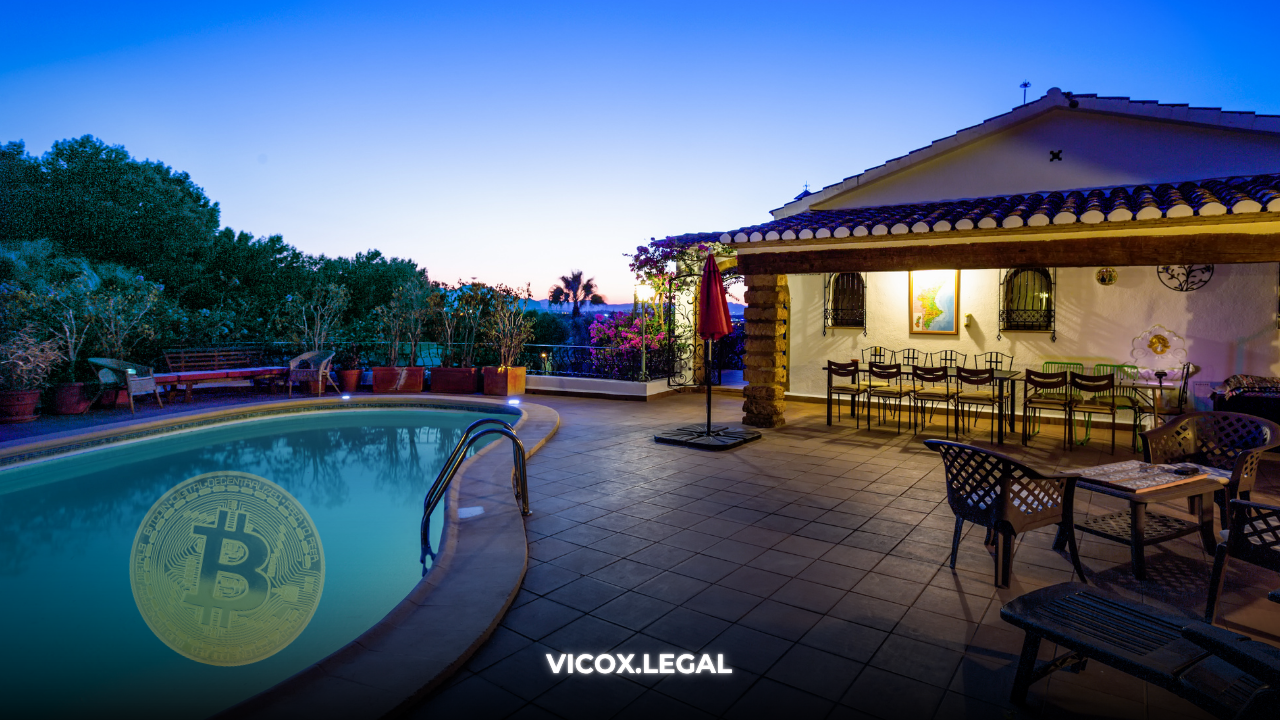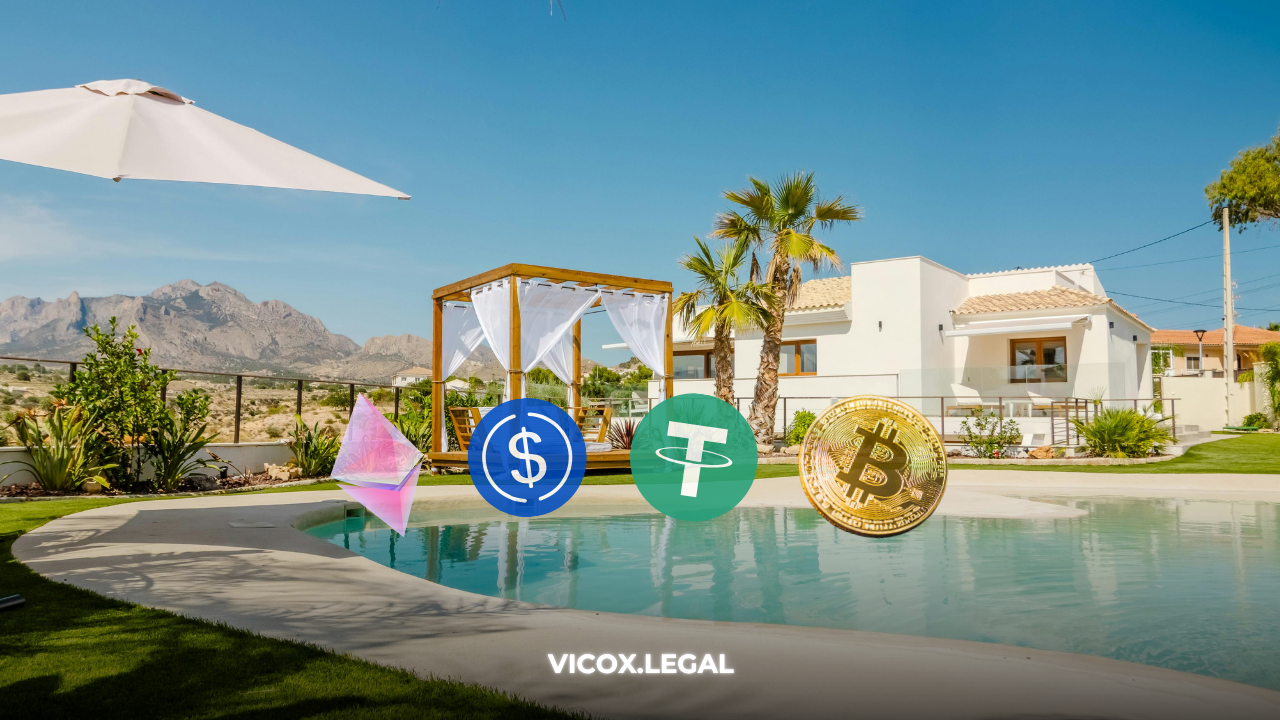
Introduction
Spain has emerged as a top-tier destination for international real estate investment, especially for high-net-worth individuals (HNWIs) in the blockchain space. Purchasing a villa in Marbella or an apartment in Madrid with Bitcoin (BTC) or other cryptocurrencies is legally sound, but it introduces a critical layer of fiscal complexity: dual taxation events resulting from the crypto-to-fiat conversion, combined with the standard taxes on real estate acquisition and ownership.
For the foreign investor, understanding the Spanish tax framework, specifically the distinction between taxes on the crypto assets and taxes on the property asset, is mandatory for compliance and avoiding penalties from the Agencia Tributaria (AEAT).
At Vicox Legal, we specialize in bridging the gap between digital assets and Spanish law, ensuring that every transaction complies with both Anti-Money Laundering (AML/KYC) regulations and the latest fiscal requirements as published in the Boletín Oficial del Estado (BOE).
This ultimate guide breaks down the Spanish crypto real estate tax landscape for non-residents in 2025, covering the three main tax categories:
- Taxation of the Crypto-to-Fiat Conversion (The Liquidity Event).
- Taxation of the Real Estate Acquisition.
- Taxes on Property Ownership and Future Sale (Non-Resident Status).
🔹 Phase 1: Taxation of the Crypto-to-Fiat Conversion
The fundamental tax challenge in a crypto real estate purchase is that the act of spending or converting the cryptocurrency into Euros (the required currency for the notarial deed and registration) is considered a taxable event in Spain.
1. The Capital Gains Tax (CGT) on Cryptocurrency (IRPF – Savings Base)
When a foreign investor sells crypto for Euros to pay for a property, the Spanish tax authority views this as a disposal of a digital asset. Any profit realized is subject to the Spanish Personal Income Tax (IRPF) on the Savings Base.
How the Gain is Calculated (FIFO Rule):
The taxable gain is the difference between the sale value (in Euros at the time of conversion/disposal) and the original acquisition value (in Euros at the time of purchase).
$$\text{Taxable Gain} = \text{Sale Value (€)} – \text{Acquisition Value (€)}$$
Spain mandates the First-In, First-Out (FIFO) method. This means you must match the Euros you receive from the sale/conversion to the oldest units of the same crypto asset you own. Accurate documentation of every single crypto transaction is crucial.
Non-Resident CGT Rates (IRPF – Savings Base, 2025)
For non-resident investors, the capital gains are taxed at progressive rates applied to the profit (the gain) generated by the conversion:
| Net Capital Gain | Non-Resident Tax Rate (2025) |
| Up to €6,000 | 19% |
| €6,000.01 to €50,000 | 21% |
| €50,000.01 to €200,000 | 23% |
| €200,000.01 to €300,000 | 27% |
| Over €300,000 | 28% |
Legal Note: This tax must be calculated and potentially settled before the final property deed signing (Escritura Pública), as the Notary Public is legally required under AML/KYC laws to verify the origin of all funds. A well-prepared legal team must have the full transaction history ready for declaration.
2. Informative Declaration Obligations (Modelo 721, etc.)
While the IRPF-Savings Base covers the gain, non-residents who later become Spanish residents, or who interact significantly with the Spanish financial system, must be aware of key reporting obligations:
- Modelo 721 (Crypto Assets Abroad): Any Spanish tax resident (including foreigners who become residents) holding crypto assets outside of Spain exceeding €50,000 must file this annual informative declaration. Failure to file can result in severe penalties.
- Modelos 172 & 173: These informative models are required for Spanish-based custodians, exchanges, and companies involved in crypto transactions. The AEAT uses the data from these models to cross-reference the declared gains of individuals.
🔹 Phase 2: Taxation of the Real Estate Acquisition
Once the crypto has been legally converted into Euros and the due diligence is complete, the purchase of the physical asset (the property) is subject to standard Spanish real estate transfer taxes.
1. Property Transfer Tax (ITP) vs. VAT (IVA)
The tax applied on the purchase depends on whether the property is new or a resale:
| Property Type | Applicable Tax | Rate (Regional Variation) |
| New-Build Property (First Transfer) | IVA (Value Added Tax) + AJD (Stamp Duty) | IVA: 10% (Residential) + AJD: 0.75% – 1.5% (Varies by region) |
| Resale Property (Second or Subsequent Transfer) | ITP (Impuesto de Transmisiones Patrimoniales) | 6% – 10% (Varies significantly by Autonomous Community) |
Key Distinction: The Permuta Ruling
A critical interpretation from the Dirección General de Tributos (DGT) (e.g., Consulta Vinculante V0935-25) suggests that the direct exchange of a property for a crypto asset (not fiat) could be treated as a permuta (barter/exchange). This may introduce specific ITP/IVA liabilities on the crypto asset itself, although in most legal transactions orchestrated by firms like Vicox Legal, the crypto is converted to Euros via a compliant escrow, making the final payment a standard Euro transfer and simplifying the process.
2. Other Mandatory Acquisition Costs (Non-Deductible)
In addition to the main transfer tax, the buyer is liable for related professional fees and government charges, typically totaling 1%–2% of the purchase price:
- Notary Fees (Aranceles Notariales): Legally mandated for the execution of the public deed (Escritura Pública).
- Land Registry Fees (Registro de la Propiedad): For registering the new owner’s title deed.
- Legal Fees (Honorarios de Abogado): Essential for due diligence, AML/KYC compliance, and tax management.
🔹 Phase 3: Taxes on Ownership and Future Sale
The foreign investor who acquires property in Spain using crypto then enters the standard non-resident tax framework for property owners.
1. Annual Taxes on Ownership
Even if you do not rent out the property, a non-resident owner faces two main annual taxes:
A. Non-Resident Imputed Income Tax (IRNR)
This tax (Impuesto sobre la Renta de No Residentes) is an annual levy on the imputed income from the property. It is based on the cadastral value of the property, reflecting the hypothetical income you could generate by renting it out.
- Taxable Base: Generally 1.1% or 2% of the property’s Valor Catastral (Cadastral Value).
- Tax Rate: A flat rate applied to the taxable base.
- EU/EEA Residents: 19%
- Non-EU/EEA Residents: 24%
- Form: Filed via Modelo 210 annually.
B. Wealth Tax (Impuesto sobre el Patrimonio – IP)
The Wealth Tax is applied to the net value of a non-resident’s assets (including the Spanish property) on December 31st of each year.
- State Exemption: There is a national minimum exemption of €700,000 on net assets.
- Regional Variation: This is crucial. While the national law sets minimums, Autonomous Communities (like Andalusia, Madrid, or Catalonia) have power over rates and exemptions:
- Andalusia (Marbella, Costa del Sol): Historically, Andalusia has applied a 100% tax rebate (de facto exemption) on the Wealth Tax, making it highly attractive for HNWIs. However, this can change annually, making legal advice essential.
- Form: Filed via Modelo 714.
C. Municipal Property Tax (IBI)
This is the local equivalent of council tax, paid annually to the local Town Hall (Ayuntamiento).
- Rate: Varies locally, typically 0.4% to 1.1% of the Valor Catastral.
2. Tax on the Future Sale of the Property
When the non-resident owner eventually sells the Spanish property, two taxes apply to the seller:
A. Capital Gains Tax on Property Sale (CGT – Non-Resident)
This is the tax on the profit made from the sale of the real estate asset.
- Calculation: Sale Price – (Acquisition Price + Acquisition Costs + Documented Improvement Costs).
- Tax Rate (Flat): 19% for all non-residents (EU/EEA and non-EU/EEA).
- Mandatory 3% Withholding: The buyer is legally required to withhold 3% of the total sale price and pay it directly to the AEAT on behalf of the non-resident seller as an advance payment toward the CGT liability. The seller then files Modelo 210 to either settle the remaining tax or claim a refund if the 3% withholding was excessive.
B. Municipal Land Value Tax (Plusvalía Municipal)
This local tax is levied on the increase in the official cadastral value of the land from the date of acquisition to the date of sale.
- Payer: Legally, the seller (unless agreed otherwise in the contract).
- Key Update: The Constitutional Court has mandated that this tax cannot be charged if the seller realizes a loss on the sale of the property (i.e., if the land value has not increased).

Real-World Tax Planning: A Case Study Example
Consider a non-resident investor purchasing a luxury villa in Marbella (Andalusia) for €2,000,000 using Bitcoin (BTC).
| Event | Action | Tax Consequence | Tax Rate/Cost |
| 1. BTC Conversion | Investor sells BTC (acquired for €1.5M) for €2.2M (to cover purchase + costs). | Capital Gain on Crypto: €700,000. | Progressive: Up to 28% on the €700K gain. |
| 2. Property Purchase | Investor buys a resale property for €2M. | Property Transfer Tax (ITP): Andalusia ITP (e.g., 8% up to €400K, 9% up to €700K, 10% over €700K). | Approx. 10% = €200,000 |
| 3. Notary & Registry | Legal and notarial finalization. | Fees: 1% – 2% of the purchase price. | ~€30,000 |
| 4. Annual Ownership | Holding the property (e.g., Catastral Value €1M). | IRNR: 19% of 1.1% of €1M. | ~€2,090 per year |
| Wealth Tax (IP): | €0 (due to Andalusia’s 100% rebate) | ||
| 5. Future Sale | Sells property for €3M (Capital Gain: €1M). | Capital Gains Tax on Property: | 19% of the €1M gain. |
Compliance Tips for Foreign Crypto Investors
- Professional Escrow is Non-Negotiable: Use a fully regulated escrow provider to execute the crypto-to-Euro conversion. This establishes a clear, traceable paper trail (Traceability & Provenance) for the Notary Public and the AEAT.
- Document Everything: Maintain complete records of the crypto’s original acquisition (exchange receipt, wallet IDs, and Euro market value at the time of purchase). Use the FIFO method consistently.
- Plan for Dual Taxation: Always budget for both the CGT on the crypto conversion and the ITP/IVA on the property purchase. The total tax burden on the liquidity event and acquisition will be significant.
- Leverage Double Taxation Agreements (DTAs): Spain has DTAs with numerous countries. Depending on your country of residence, you may be able to claim a deduction or credit in your home country for taxes paid in Spain, preventing you from being taxed twice on the same income or gain.
Final Thoughts: Legal Certainty in a Complex Market
Navigating Spain’s crypto real estate taxes as a foreigner requires more than a standard real estate lawyer; it demands a specialist with proven expertise in both international tax law and blockchain compliance.
The use of crypto as a payment method is a legally valid disposition of assets under Spanish law, but its unique tax implications—particularly the realization of a capital gain upon conversion—must be meticulously planned.
Vicox Legal provides end-to-end tax advisory and legal structuring for international investors, covering:
- Crypto Tax Optimization and FIFO compliance.
- AML/KYC Verification for Notary and AEAT requirements.
- Non-Resident Tax Filing (Modelo 210, Modelo 714, IBI).
- Legal Structuring to minimize future tax exposure (e.g., Wealth Tax planning).
Ready to secure your Spanish property with the highest level of fiscal compliance?
🔹 Contact Vicox Legal for a confidential consultation.
FAQs – Spain Crypto Tax & Property
If I use stablecoins (USDT/USDC), do I still pay CGT on the conversion?
Yes. Spanish law treats all cryptocurrencies, including stablecoins, as digital assets. The conversion of USDT to euros is considered a disposal, and if your original acquisition cost of the stablecoin was lower than the sale price, the realized gain is taxable. However, since stablecoins have minimal price fluctuation, any taxable gain is typically small, reducing your overall tax exposure.
Do I need a Spanish bank account to complete the purchase?
No, you don’t necessarily need one. What’s essential is a legal and traceable method to convert your crypto into euros, which must then be transferred through a regulated financial intermediary—such as an escrow service or licensed OTC desk—to the seller. While having a Spanish bank account simplifies future payments like IBI or utilities, it’s not mandatory for the property purchase itself.
How does the AEAT know I paid with Bitcoin?
Under Spanish AML Law 10/2010, notaries are legally required to verify the origin of all funds involved in property purchases. For crypto transactions, this means providing proof of the crypto-to-fiat conversion, along with acquisition documentation. Additionally, the AEAT now receives data from informative models (Modelo 172/173) and international reporting frameworks (DAC8/CARF), allowing Spanish authorities to trace crypto ownership and transactions globally.
References
- Agencia Tributaria – Fiscalidad Criptomonedas
- Boletín Oficial del Estado (BOE)
- Registro de la Propiedad – Ministerio de Justicia
- Crypto-Friendly Real Estate Agents in Spain – 2025 Update
- Crypto Real Estate Spain – Step by Step
- Buy Real Estate with Crypto in Spain
Related Articles – Deepening Your Legal Knowledge
For a complete and secure journey into Spanish crypto real estate, explore our full library of expert guides:
- The Ultimate Legal Guide: Buy Property in Spain with Crypto: The Comprehensive 2025 Guide
- A foundational resource covering regulations, security, and market overview.
- Procedural Roadmap: Crypto Real Estate Spain – Step-by-Step Process for Foreign Investors
- Detailed actions from initial due diligence to final registration.
- Legal Compliance and Escrow: The Legal Process to Buy Real Estate in Spain Using Crypto (AML/KYC)
- Focus on AML compliance, notarial requirements, and fund verification.




